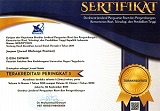Communication of the South Korean women's archery team at the 2020 Tokyo olympics
DOI:
https://doi.org/10.21831/jorpres.v20i2.74688Keywords:
Olympics.com, Semiotics, South korean women's archery, Sport communication, Team's communication.Abstract
The victory of each athlete in achieving peak performance in the midst of competition depends on the communication skills of players and coaches. When competing in a competition, communication is very important and cannot be ignored. Whether in individual or group numbers in the middle of the competition, communication becomes even closer. The purpose of this research is to see how athletes and coaches of the South Korean archery women's team communicate during the 2020 Tokyo Olympics finals. This research method is using semiotics (Peirce), the performance of the South Korean women's archery team in the final of the women's team competition is examined. The conclusion of this study shows that communication between archers and coaches is dominated by non-verbal communication in the women's team symbolised by high-fives.References
Al-Yamani, Z. (2021). Sejarah Panjang Dominasi Korsel di Panahan Olimpiade. https://www.viva.co.id/sport/gelanggang/1390231-sejarah-panjang-dominasi-korsel-di-panahan-olimpiade
Creswell, J., & Poth, C. (2017). Qualitative inquiry and research design: Choosing among five approaches. Sage publications.
Faisal, F., Zulham, Z., Syukur, A., & Safitri, D. (2018). Hubungan Komunikasi dengan Prestasi Atlet. Communicatus: Jurnal Ilmu Komunikasi, 2(1), 97–108. https://doi.org/10.15575/cjik.v2i1.1625
Hambrick, M. (2017). Sport communication research: A social network analysis. Sport Management Review, 20(2), 170–183. https://doi.org/10.1016/j.smr.2016.08.002
Hardy, M., & Susilo, D. (2022). Jakarta's urban culture representation on social media@ jakarta_tourism: A semiotics analysis. Simulacra, 5(1), 29–43. https://doi.org/10.21107/sml.v5i1.13648
Indahwati, N., & Ristanto, K. (2016). The application of pettlep imagery exercise to competitive anxiety and concentration in Surabaya archery athletes. International Journal of Educational Science and Research (IJESR), 6(3).
Kamelia, K. (2019). Using Video as Media of Teaching in English Language Classroom: Expressing Congratulation and Hopes. Utamax: Journal of Ultimate Research and Trends in Education, 1(1), 34–38. https://doi.org/10.31849/utamax.v1i1.2742
Kim, Y., Chang, T., & Park, I. (2019). Visual scanning behavior and attention strategies for shooting among expert versus collegiate Korean archers. Perceptual and Motor Skills, 126(3), 530–545. https://doi.org/10.1177/0031512519829624
Kim, Y., & Park, I. (2020). "Coach Really Knew What I Needed and Understood Me Well as a Person": Effective Communication Acts in Coach–Athlete Interactions among Korean Olympic Archers. International Journal of Environmental Research and Public Health, 17(9), 3101. https://doi.org/10.3390/ijerph17093101
Meyer, C., & Wedelstaedt, U. (2022). Semiotic and asemiotic practices in boxing. Semiotica, 2022(248), 251–278. https://doi.org/10.1515/sem-2022-0075
Meyer, O., Omdahl, M., & Makransky, G. (2019). Investigating the effect of pre-training when learning through immersive virtual reality and video: A media and methods experiment. Computers & Education, 140(October), 103603. https://doi.org/10.1016/j.compedu.2019.103603
Nauright, J. (2012). Sports around the World: History, Culture, and Practice [4 volumes]: History, Culture, and Practice. Abc-Clio.
Oktafiranda, N., & Ilham, M. (2020). Komunikasi Antarpribadi Pelatih Dan Atlet Panahan PELATDA DKI Jakarta. JURNAL SEGAR, 9(1), 54–62. https://doi.org/10.21009/segar/0901.06
Olympics.com. (2021). Women's Team Champion. https://olympics.com/en/video/women-s-team-qfs-sfs-finals-archery-tokyo-2020-replays
Olympics.com. (2022). Halaman Profil Olympics. https://olympics.com/
Pedersen, P., Laucella, P., Miloch, K., & Fielding, L. (2007). The juxtaposition of sport and communication: Defining the field of sport communication. International Journal of Sport Management and Marketing, 2(3), 193–207. https://doi.org/10.1504/IJSMM.2007.012400
Peirce, C. (1977). Semiotics and significs, ed. Charles Hardwick. Bloomington IN: Indiana University Press.
Putranto, T. (2021). Instagram Panahan Korea Selatan Pada Olimpiade Tokyo 2020 Dalam Perspektif Determinisme Teknologi. Scriptura, 11(2), 65–73. https://doi.org/https://doi.org/10.9744/scriptura.11.2.65-73
Putranto, T. (2022). Komunikasi Kelompok Recurve Beregu Putri Jawa Timur Pada Pekan Olahraga Nasional XX. Jurnal Pustaka Komunikasi, 5(2), 344–357. https://doi.org/10.32509/pustakom.v5i2.2198
Reftari, D., Suryana, A., & Setiaman, A. (2018). Komunikasi Pemasaran Olahraga Renang. Jurnal Kajian Komunikasi, 6(2), 247–260. https://doi.org/https://doi.org/10.24198/jkk.v6i2.13221
Sepadya, P., Rachmah, N., & Ali, M. (2020). Internalisasi Nilai-Nilai Pendidikan Karakter Dalam Olahraga Panahan. Universitas Muhammadiyah Surakarta.
Sobur, A. (2001). Analisis teks media: Suatu pengantar untuk analisis wacana, analisis semiotik dan analisis framing. Bandung: Remaja Rosdakarya.
Worldarchery. (2021). Tokyo 2020 Olympic Games. https://worldarchery.sport/competition/14904/tokyo-2020-olympic-games?photos_tag=17 JULY VENUE
Yonhap. (2021). [Tokyo Olympics] Why is S. Korea so good at archery? Athletes find answer in transparency, internal competition. http://www.koreaherald.com/view.php?ud=20210726000558
Zaimar, O. (2014). Semiotika dalam analisis karya sastra. PT Komodo Books.
Downloads
Published
How to Cite
Issue
Section
License
Authors who publish with this journal agree to the following terms:
- Authors retain copyright and grant the journal right of first publication with the work simultaneously licensed under a Creative Commons Attribution License that allows others to share the work with an acknowledgement of the work's authorship and initial publication in this journal.
- Authors are able to enter into separate, additional contractual arrangements for the non-exclusive distribution of the journal's published version of the work (e.g., post it to an institutional repository or publish it in a book), with an acknowledgement of its initial publication in this journal.
- Authors are permitted and encouraged to post their work online (e.g., in institutional repositories or on their website) prior to and during the submission process, as it can lead to productive exchanges, as well as earlier and greater citation of published work (See The Effect of Open Access).




